Remote Sensing Publications 1961–2023—Analysis of National and Global Trends
Abstract
1. Introduction
2. Methodology
2.1. Data Sources
2.2. Attribute Harmonization
2.3. Cleaning
3. Results and Discussion
3.1. Publication Growth
3.2. Journal Publishing Trends
3.3. Authorship Trends
3.4. Geographic Scholarship Distributions
3.5. National Production Trends
3.6. National Funding Trends
3.7. Technology and Application Trends
3.8. Contributions
3.9. Growth in Publications
3.10. Cycles of Funding, Papers, and Resulting Patents
4. Conclusions
Author Contributions
Funding
Institutional Review Board Statement
Informed Consent Statement
Data Availability Statement
Conflicts of Interest
Abbreviations
| ML | Machine Learning |
| DL | Deep Learning |
Appendix A
| Attribute | Data Type | Description | Notes |
|---|---|---|---|
| Title | String | Article title | |
| Accession number | Long | A unique 14-digit number assigned to each record assigned by EV | |
| Author | String | All authors | |
| Author affiliation | String | Authors’ corresponding affiliations | |
| Corresponding author(s) | String | One of the authors and a contact | |
| Source | String | Journal | |
| Abbreviated source title | String | Abbreviated journal title | |
| Publisher | String | Publisher | |
| Volume | Int | Volume | |
| Issue | Int | Issue | |
| Pages | String | Pages | |
| Issue date | Date | Issue date | |
| Publication date | Date | Mostly publication year, sometimes contains month | |
| Publication year | Year | Publication year | Compendex only |
| Language | String | Language | |
| ISSN | Int | ISSN | |
| E-ISSN | Int | E-ISSN | |
| DOI | String | Digital Object Identifier | |
| Article number | Int | Article number | |
| CODEN | String | Six-character representations of source titles | |
| Country of publication | String | Country of publication | |
| Document type | String | Document type; journal article in our case | |
| Abstract | String | Abstract of the article | |
| Number of references | Int | Number of references | |
| Main heading | String | A subject classification that serves to represent the main topic of the document | Compendex only |
| Controlled/subject terms | String | A list of subject terms used to describe the content of a document in the most specific and consistent way possible | |
| Uncontrolled terms | String | Not assigned from the Engineering Village’s Thesaurus, but derived from the abstract and author keywords | |
| Classification code | String | A numerical hierarchy of general subject categories | |
| IPC code | String | International Patent Classification (IPC) codes pertain to a hierarchical classification for patents for different areas of technology | Inspec only |
| CPC code | String | Cooperative Patent Classification (CPC) system was jointly developed by the European Patent Office (EPO) and the United States Patent and Trademark Office (USPTO) | Inspec only |
| Treatment | String | Nature of the content based on the focus | |
| Discipline | String | Discipline | Inspec only |
| Funding details | String | Sponsors; missing values exist | |
| Funding text | String | More details about the funding | |
| Open access type(s) | String | Open Access, Gold, Hybrid Gold, Bronze, Green | Compendex only |
| Database | String | Compendex/Inspec | |
| Copyright | String | Copyright | |
| Data provider | String | Engineering Village |
| Country/Region | Color |
|---|---|
| US | Cornflower blue |
| UK | Gold |
| Canada | Peru |
| China | #EB4D4D |
| Israel | Pink |
| Netherlands | Lawn green |
| Romania | Lime green |
| Japan | Gray |
| France | Dark sea green |
| USSR | Light coral |
| Germany | Yellow green |
| Australia | Cyan |
| India | Wheat |
| Italy | #AA70F6 |
| Russia | Light salmon |
| Spain | Light green |
| Europe | Medium sea green |
| Sweden | Forest green |
| Country (Color) | Sponsors |
|---|---|
| US (blue) | NASA: National Aeronautics and Space Administration |
| NSF: National Science Foundation | |
| ONR: Office of Naval Research JPL: Jet Propulsion Laboratory DOE: | |
| U.S. Department of Energy JSC: Johnson Space Center | |
| NOAA: National Oceanic and Atmospheric Administration | |
| China (red) | NNSF: National Natural Science Foundation of China |
| CAS: Chinese Academy of Sciences | |
| NKRDP: National Key Research and Development Program of China | |
| 973 Prgm: National Basic Research Program of China (973 Program) | |
| FRFCU: Fundamental Research Funds for the Central Universities | |
| PSF: China Postdoctoral Science Foundation | |
| Canada (brown) | NSERC: Natural Sciences and Engineering Research Council of Canada |
| Europe (green) | ESA: European Space Agency EC: European Commission |
| Horizon 2020: Horizon 2020 Framework Programme | |
| UK (yellow) | NERC: Natural Environment Research Council |
| Italy (purple) | AST: Agenzia Spaziale Italiana |
Appendix B
| Journal | 1961–1970 | 1971–1980 | 1981–1990 | 1991–2000 | 2001–2010 | 2011–2020 | 2021–2023 |
|---|---|---|---|---|---|---|---|
| ASCE J. of Surveying & Mapping Div. | x | ||||||
| American Soc. for Photogrammetry & Remote Sensing | x | x | x | ||||
| Applied Sciences | x | x | |||||
| Applied Spectroscopy | x | x | x | x | x | x | |
| Arabian J. of Geosciences | x | x | |||||
| Australian J. of Geodesy, Photogrammetry & Surveying | x | x | |||||
| Australian Surveyor | x | x | |||||
| Automation in Construction | x | ||||||
| Bulletin Geodesique | x | ||||||
| Canadian J. of Remote Sensing | x | x | x | x | x | x | |
| Canadian Surveyor | x | x | |||||
| Chinese Geodetic & Cartographic Journal (in Chinese, Cehui Xuebao) | x | x | x | ||||
| Computers & Geosciences | x | x | x | x | x | ||
| Computers, Environment & Urban Systems | x | x | x | ||||
| Earsel Advances in Remote Sensing | x | ||||||
| Earth Observation & Remote Sensing | x | ||||||
| Earth-Oriented Applications of Space Technology | x | ||||||
| Egyptian J. of Remote Sensing & Space Science | x | x | |||||
| European J. of Remote Sensing | x | x | |||||
| French J. of Photogrammetry & Remote Sensing | x | x | |||||
| French Soc. of Photogrammetry | x | ||||||
| French Soc. of Photogrammetry & Remote Sensing | x | x | x | x | |||
| Geo-Spatial Information Science | x | x | x | ||||
| Geojournal | x | x | x | x | x | ||
| Geomatics & Information Science of Wuhan Univ. | x | x | x | ||||
| Geomatics, Natural Hazards & Risk | x | x | x | ||||
| Geospatial Solutions | x | ||||||
| Geoscience & Remote Sensing | x | x | |||||
| IEEE Geoscience & Remote Sensing Letters | x | x | x | ||||
| IEEE Geoscience & Remote Sensing Magazine | x | x | |||||
| IEEE J. of Selected Topics in Applied Earth Observations & Remote Sensing | x | x | x | ||||
| IEEE Trans. on Geoscience Electronics | x | x | |||||
| IEEE Trans. on Geoscience & Remote Sensing | x | x | x | x | x | x | |
| IEEE Trans. on Image Processing | x | x | x | x | |||
| International Geoscience & Remote Sensing Symp. | x | x | |||||
| International J. of Applied Earth Observation and Geoinformation | x | x | |||||
| International J. of Digital Earth | x | x | |||||
| International J. of Remote Sensing | x | x | x | x | x | ||
| ISPRS International J. of Geo-Information | x | x | |||||
| ISPRS J. of Photogrammetry & Remote Sensing | x | x | x | x | x | ||
| ITC J. | x | x | |||||
| J. of Applied Photographic Engineering | x | x | |||||
| J. of Applied Remote Sensing | x | x | x | ||||
| Journal of Applied Spectroscopy | x | x | |||||
| J. of Flight Science & Space Research (in German) | x | ||||||
| J. of Geo-Information Science | x | ||||||
| J. of Geodesy | x | x | x | ||||
| J. of Geomatics | x | ||||||
| J. of Geophysical Research | x | x | x | x | x | ||
| J. of Imaging Technology | x | ||||||
| J. of Quantitative Spectroscopy & Radiative Transfer | x | x | x | x | x | x | |
| J. of Sensors | x | x | |||||
| J. of Surveying Engineering | x | x | x | x | x | ||
| J. of Surveying German | x | x | x | ||||
| J. of the Indian Soc. of Remote Sensing | x | x | x | ||||
| J. of the Optical Soc. of America | x | x | x | x | |||
| Open Geosciences | x | ||||||
| Optoelectronics, Instrumentation & Data Processing | x | x | x | x | x | x | |
| Photogrammetria | x | x | x | ||||
| Photogrammetric Engineering | x | x | |||||
| Photogrammetric Engineering & Remote Sensing | x | x | x | x | x | x | |
| Photogrammetric Record | x | x | x | x | x | ||
| Proc. of the IEEE | x | x | x | x | x | x | x |
| Radiotekhnika | x | ||||||
| Remote Sensing, MDPI | x | x | x | ||||
| Remote Sensing Applications/Society and Environment | x | x | |||||
| Remote Sensing Letters | x | x | x | ||||
| Remote Sensing Reviews | x | x | |||||
| Remote Sensing of Environment | x | x | x | x | x | x | x |
| Science of Surveying & Mapping | x | ||||||
| Sensors | x | x | x | x | |||
| Spectroscopy & Spectral Analysis (in Chinese, Guang Pu Xue Yu Guang Pu Fen Xi) | x | x | x | ||||
| Solar System Research | x | x | x | x | x | x | |
| Soviet J. of Optical Technology | x | ||||||
| Soviet J. of Remote Sensing | x | x | |||||
| J. of Remote Sensing (in Chinese, Yaogan Xuebao) | x | x |
Appendix C
| Period | Country | Sector | Entities | Percent (%) |
|---|---|---|---|---|
| 1961–1970 | US | Government | 2 | 4.8 |
| University | 0 | 0 | ||
| Private | 17 | 36 | ||
| Total | 19 | 40.8 | ||
| 1971–1980 | US | Government | 2 | 2.8 |
| University | 0 | 0 | ||
| Private | 11 | 6.2 | ||
| Total | 13 | 9 | ||
| Japan | Government | 0 | 0 | |
| University | 0 | 0 | ||
| Private | 3 | 2.7 | ||
| Total | 3 | 2.7 | ||
| Canada | Government | 0 | 0 | |
| University | 0 | 0 | ||
| Private | 1 | 0.8 | ||
| Total | 1 | 0.8 | ||
| USSR | Government | 0 | 0 | |
| University | 0 | 0 | ||
| Private | 1 | 0.8 | ||
| Total | 1 | 0.8 | ||
| Sweden | Government | 0 | 0 | |
| University | 0 | 0 | ||
| Private | 1 | 0.5 | ||
| Total | 1 | 0.5 | ||
| 1981–1990 | US | Government | 3 | 1.5 |
| University | 1 | 0.4 | ||
| Private | 6 | 4.2 | ||
| Total | 10 | 6.1 | ||
| Japan | Government | 0 | 0 | |
| University | 0 | 0 | ||
| Private | 5 | 14 | ||
| Total | 5 | 14 | ||
| UK | Government | 0 | 0 | |
| University | 0 | 0 | ||
| Private | 1 | 0.7 | ||
| Total | 1 | 0.7 | ||
| India | Government | 1 | 0.6 | |
| University | 0 | 0 | ||
| Private | 0 | 0 | ||
| Total | 1 | 0.6 | ||
| China | Government | 0 | 0 | |
| University | 0 | 0 | ||
| Private | 1 | 0.5 | ||
| Total | 1 | 0.5 | ||
| 1991–2000 | US | Government | 3 | 1.7 |
| University | 0 | 0 | ||
| Private | 7 | 4.1 | ||
| Total | 10 | 5.8 | ||
| Japan | Government | 0 | 0 | |
| University | 0 | 0 | ||
| Private | 5 | 4.5 | ||
| Total | 5 | 4.5 | ||
| China | Government | 1 | 0.6 | |
| University | 0 | 0 | ||
| Private | 0 | 0 | ||
| Total | 1 | 0.6 | ||
| Germany | Government | 1 | 0.5 | |
| University | 0 | 0 | ||
| Private | 0 | 0 | ||
| Total | 1 | 0.5 | ||
| 2001–2010 | China | Government | 7 | 7.7 |
| University | 10 | 14.6 | ||
| Private | 1 | 0.9 | ||
| Total | 18 | 23.2 | ||
| Germany | Government | 1 | 1.1 | |
| University | 0 | 0 | ||
| Private | 0 | 0 | ||
| Total | 1 | 1.1 | ||
| 2011–2020 | China | Government | 5 | 8.8 |
| University | 13 | 27 | ||
| Private | 1 | 0.9 | ||
| Total | 19 | 36.7 | ||
| 2021–2023 | China | Government | 5 | 8.4 |
| University | 11 | 16.3 | ||
| Private | 3 | 3.1 | ||
| Total | 19 | 27.8 |
References
- NASA Earthdata. What Is Remote Sensing? Available online: https://www.earthdata.nasa.gov/learn/earth-observation-data-basics/remote-sensing (accessed on 5 September 2025).
- Kumar, S. GeoBuiz 22: Global Geospatial Industry Outlook Report. Available online: https://geospatialworld.net/gw-market-insights/advancing-augmenting-usd-1-4-trillion-geospatial-market-by-2030/ (accessed on 16 June 2025).
- Terhune, E.A. Collapsible Mast. U.S. Patent 2,832,555, 29 April 1958. [Google Scholar]
- Duncan, P.M. On Some Fossil Reef-Building Corals from the Tertiary Deposits of Tasmania. Q. J. Geol. Soc. 1876, 32, 341–351. [Google Scholar] [CrossRef]
- Flemer, J.A. An Elementary Treatise on Phototopographic Methods and Instruments; John Wiley and Sons: New York, NY, USA, 1906. [Google Scholar]
- Custance, N.D.E. The Application of Terrain Classification Techniques to Visible Near Infra-red and Thermal Infra-red Imagery. Ph.D. Thesis, University of London, London, UK, 1934. Available online: https://core.ac.uk/download/pdf/78864948.pdf (accessed on 5 September 2025).
- Myers, V.I.; Allen, W.A. Electrooptical Remote Sensing Methods as Nondestructive Testing and Measuring Techniques in Agriculture. Appl. Opt. 1968, 7, 1819–1838. [Google Scholar] [CrossRef] [PubMed]
- Klemas, V.; Odell, E.L.G. Multispectral Imaging of Mars from a Lander; No. NASA-CR-66827; NASA: Washington, DC, USA, 1969.
- Bristor, C.L. The Earth Location of Geostationary Satellite Imagery. Pattern Recognit. 1970, 2, 269–277. [Google Scholar] [CrossRef]
- Colvocoresses, A.P. ERTS-A Satellite Imagery. Photogramm. Eng. 1970, 36, 555–561. [Google Scholar]
- Victor, N.; Maddikunta, P.K.R.; Mary, D.R.K.; Murugan, R.; Chengoden, R.; Gadekallu, T.R.; Rakesh, N.; Zhu, Y.; Paek, J. Remote Sensing for Agriculture in the Era of Industry 5.0—A Survey. IEEE J. Sel. Top. Appl. Earth Obs. Remote Sens. 2024, 17, 5920–5945. [Google Scholar] [CrossRef]
- Alipouri, E.; Nami, M.H.; Naderi, M. An Overview of the Application of Remote Sensing Technologies in Disaster Management (with an Emphasis on Natural Hazards). Disaster Prev. Manag. Knowl. 2024, 13, 490–507. [Google Scholar] [CrossRef]
- Zhuang, Y.; Liu, X.; Nguyen, T.; He, Q.; Hong, S. Global Remote Sensing Research Trends During 1991–2010: A Bibliometric Analysis. Scientometrics 2013, 96, 203–219. [Google Scholar] [CrossRef]
- Zhang, Y.; Thenkabail, P.S.; Wang, P. A Bibliometric Profile of the Remote Sensing Open Access Journal Published by MDPI Between 2009 and 2018. Remote Sens. 2019, 11, 91. [Google Scholar] [CrossRef]
- Engineering Village. Available online: https://www.engineeringvillage.com (accessed on 7 May 2025).
- Elsevier. Engineering Village Databases. Available online: https://www.elsevier.com/products/engineering-village/databases (accessed on 7 May 2025).
- National Science Foundation (NSF). Publication Output by Region, Country, or Economy and by Scientific Field. Available online: https://ncses.nsf.gov/pubs/nsb202333/publication-output-by-region-country-or-economy-and-by-scientific-field (accessed on 7 May 2025).
- Neumann, T.; Dülberg, E.; Schiffer, S.; Ferrein, A. A rotating platform for swift acquisition of dense 3D point clouds. In Intelligent Robotics and Applications: 9th International Conference, ICIRA 2016, Tokyo, Japan, August 22–24, 2016, Proceedings, Part I; Springer International Publishing: Cham, Switzerland, 2016; pp. 257–268. [Google Scholar]
- Chen, S.; Laefer, D.F.; Mangina, E. State of technology review of civilian UAVs. Recent Pat. Eng. 2016, 10, 160–174. [Google Scholar] [CrossRef]
- Laghari, A.A.; Jumani, A.K.; Laghari, R.A.; Nawaz, H. Unmanned aerial vehicles: A review. Cogn. Robot. 2023, 3, 8–22. [Google Scholar] [CrossRef]
- Vo, A.V.; Truong-Hong, L.; Laefer, D.F.; Bertolotto, M. Octree-based region growing for point cloud segmentation. ISPRS J. Photogramm. Remote Sens. 2015, 104, 88–100. [Google Scholar] [CrossRef]
- United States Geological Survey (USGS). 3D Elevation Program. Available online: https://www.usgs.gov/3d-elevation-program (accessed on 7 May 2025).
- OpenAI. ChatGPT (June 9 Version). 2025. Available online: https://chat.openai.com/ (accessed on 5 September 2025).
- Google Patents. Remote Sensing Patent Search. Available online: https://patents.google.com (accessed on 7 May 2025).
- Glismann, H.H.; Horn, E.J. Comparative invention performance of major industrial countries: Patterns and explanations. Manag. Sci. 1988, 34, 1169–1187. [Google Scholar] [CrossRef][Green Version]
- Raghupathi, V.; Raghupathi, W. Innovation at country-level: Association between economic development and patents. J. Innov. Entrep. 2017, 6, 4. [Google Scholar] [CrossRef]
- Ye, Y.; Xu, S.; Mariani, M.S.; Lü, L. Forecasting countries’ gross domestic product from patent data. Chaos Solitons Fractals 2022, 160, 112234. [Google Scholar] [CrossRef]
- Paula, F.D.O.; Silva, J.F.D. R&D spending and patents: Levers of national development. Innov. Manag. Rev. 2021, 18, 175–191. [Google Scholar] [CrossRef]
- Kwon, S.; Lee, J.; Lee, S. International trends in technological progress: Evidence from patent citations, 1980–2011. Scientometrics 2017, 127, F50–F70. [Google Scholar]
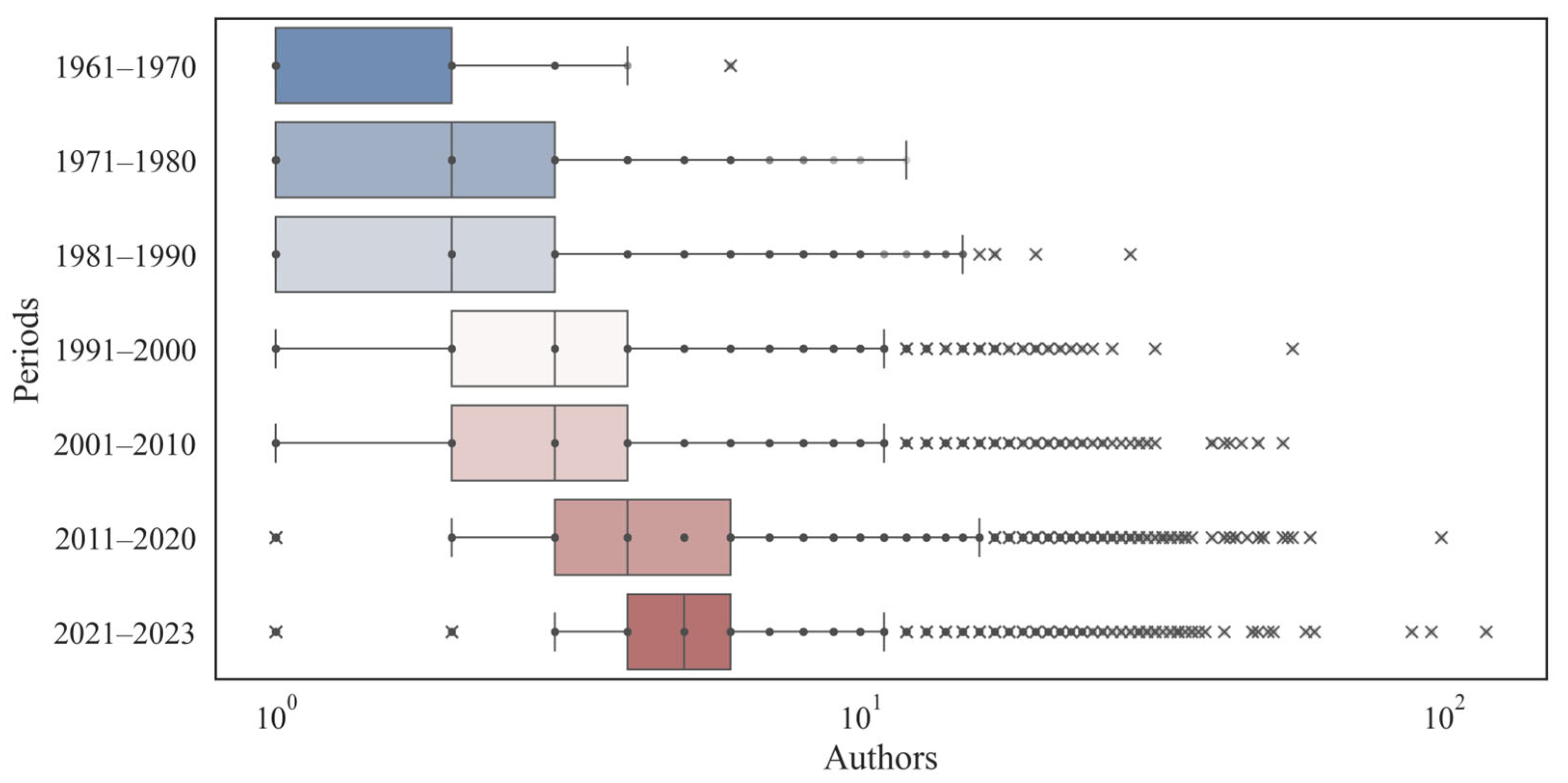
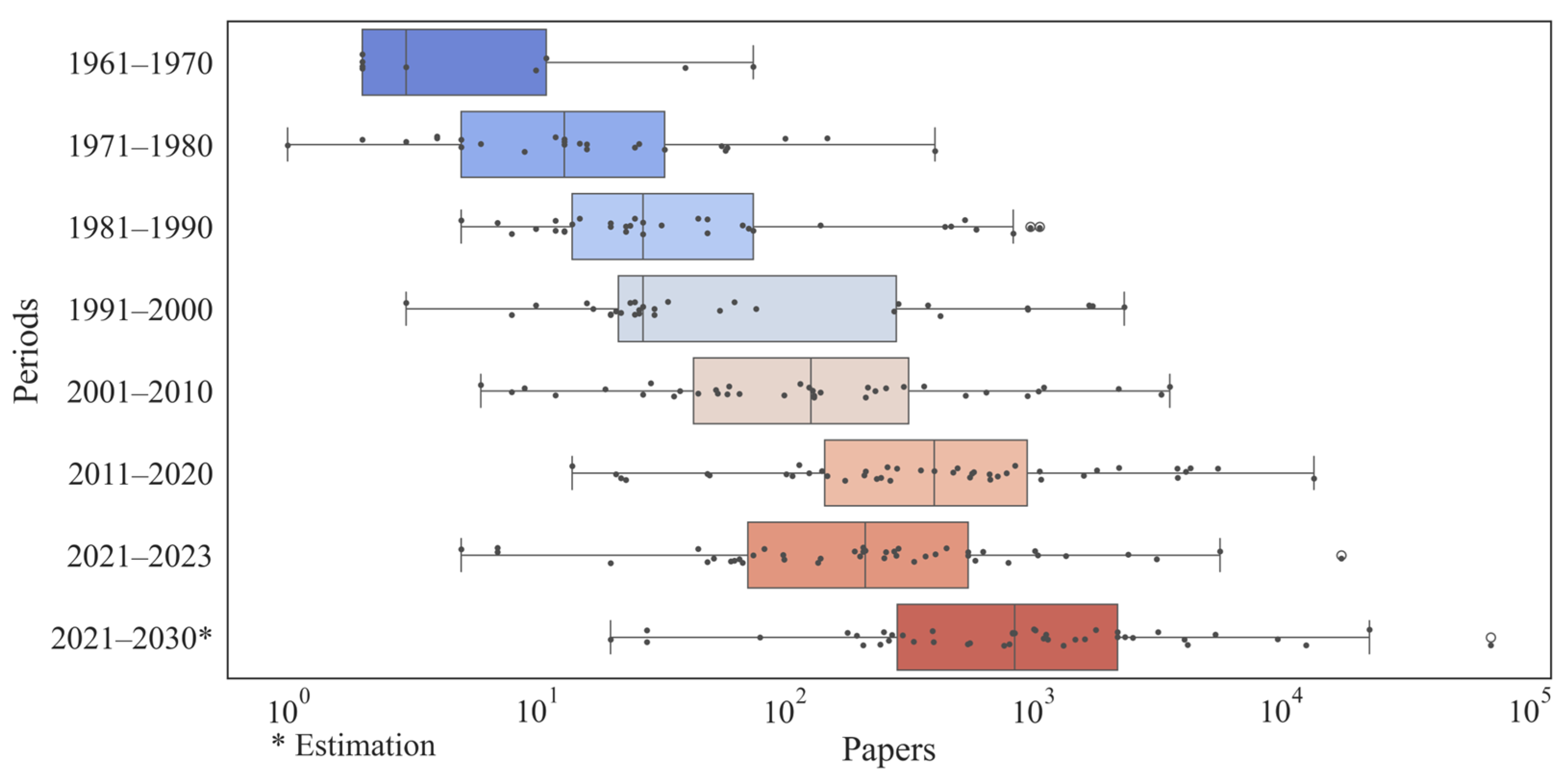
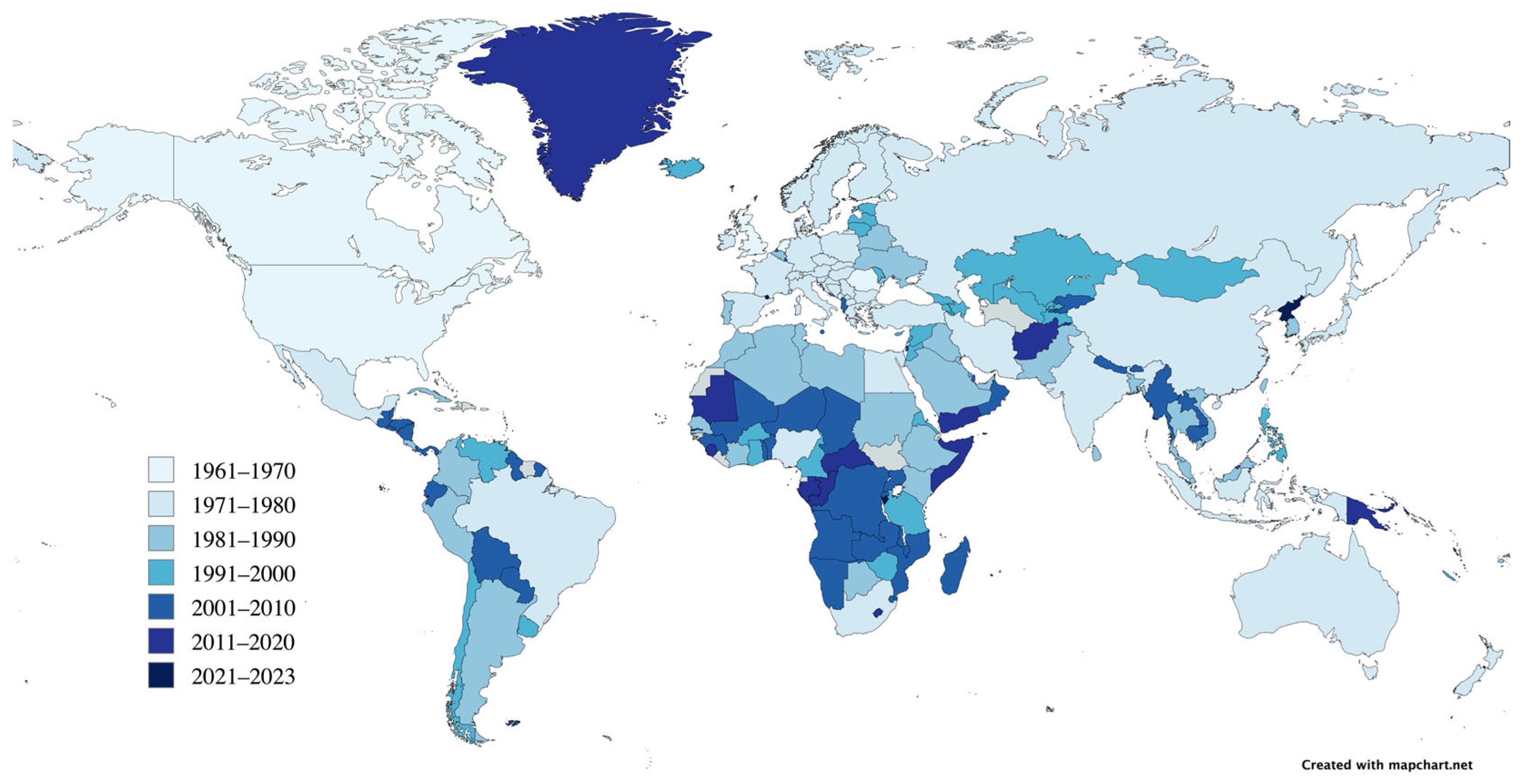


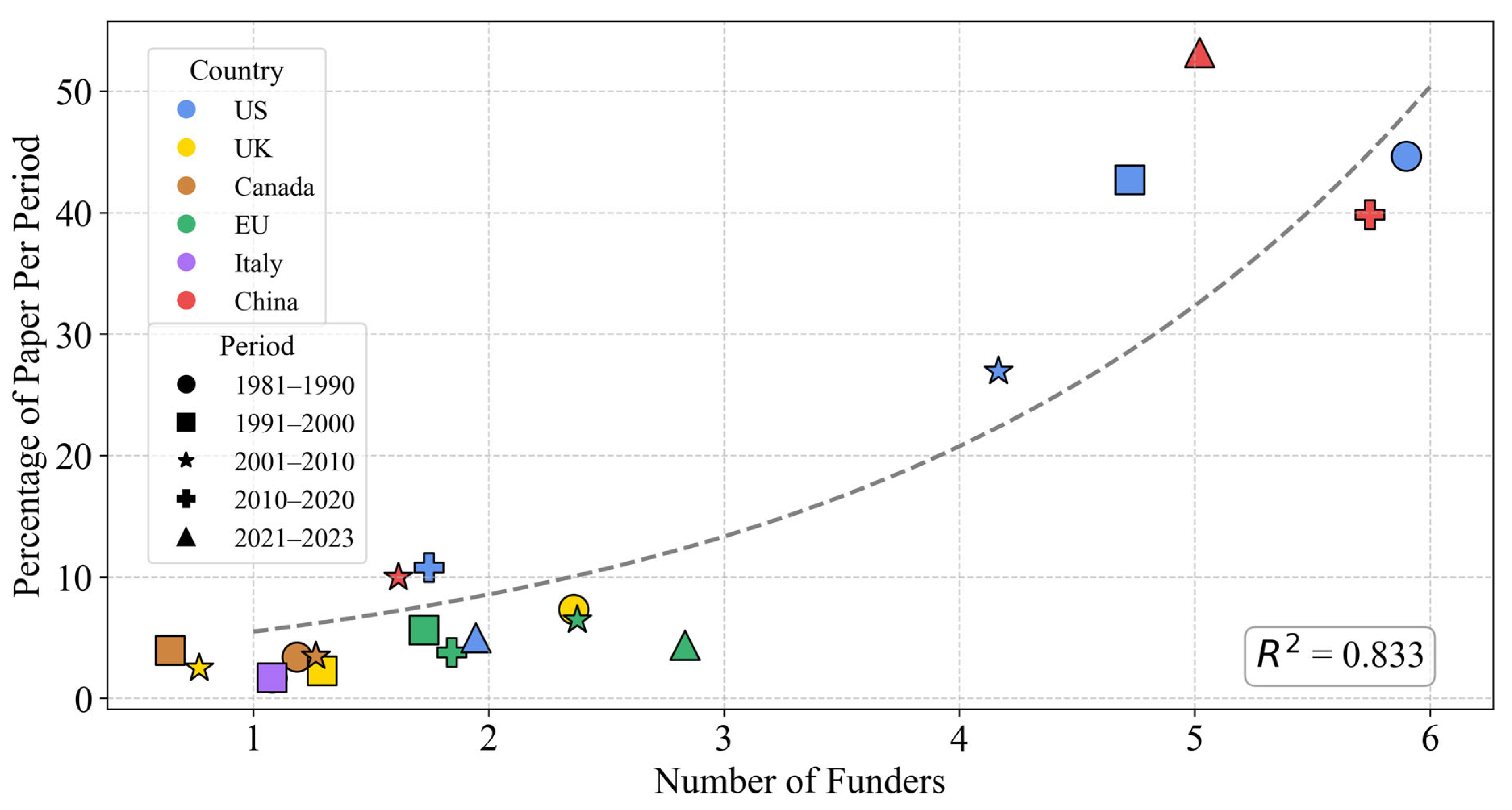
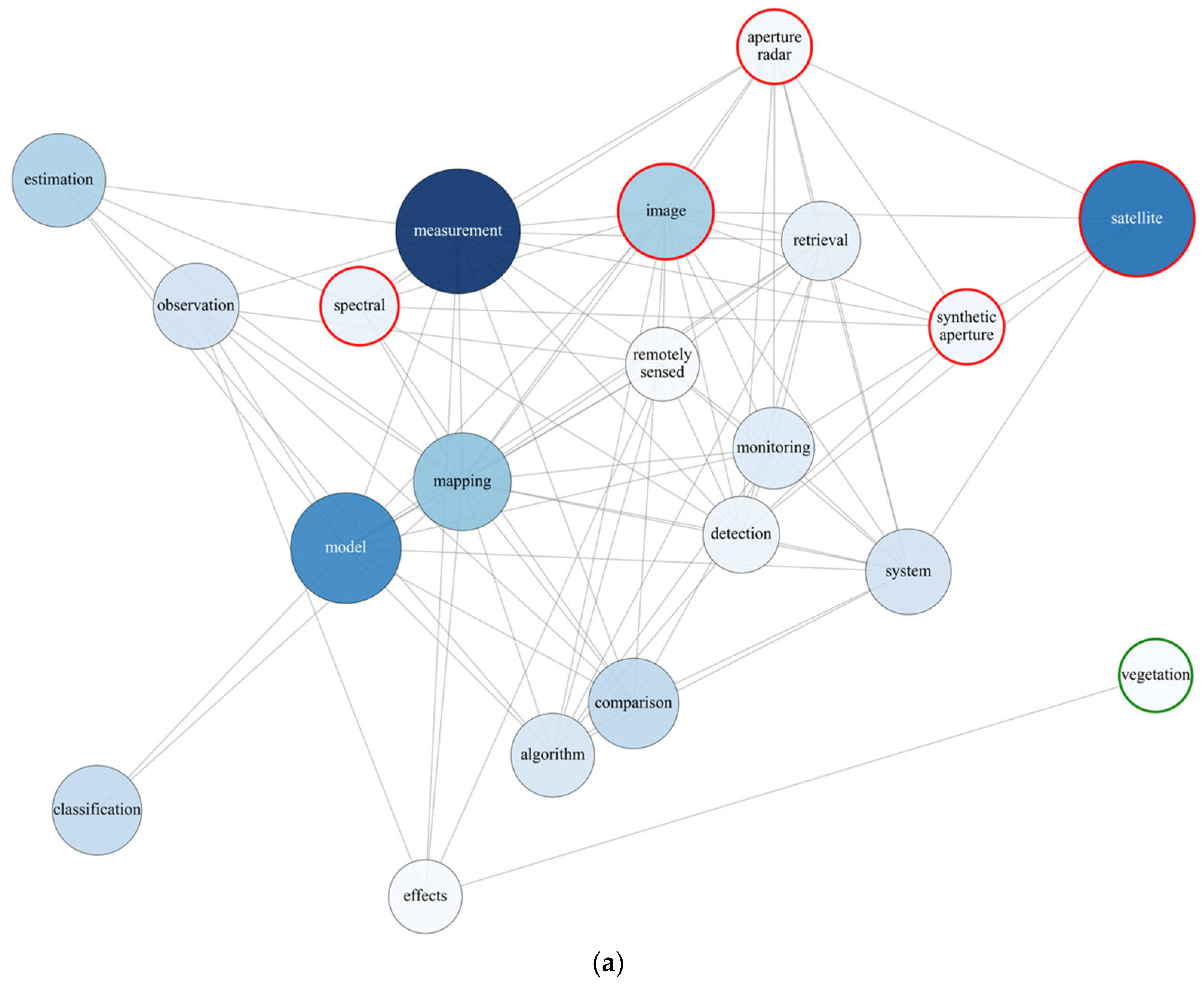

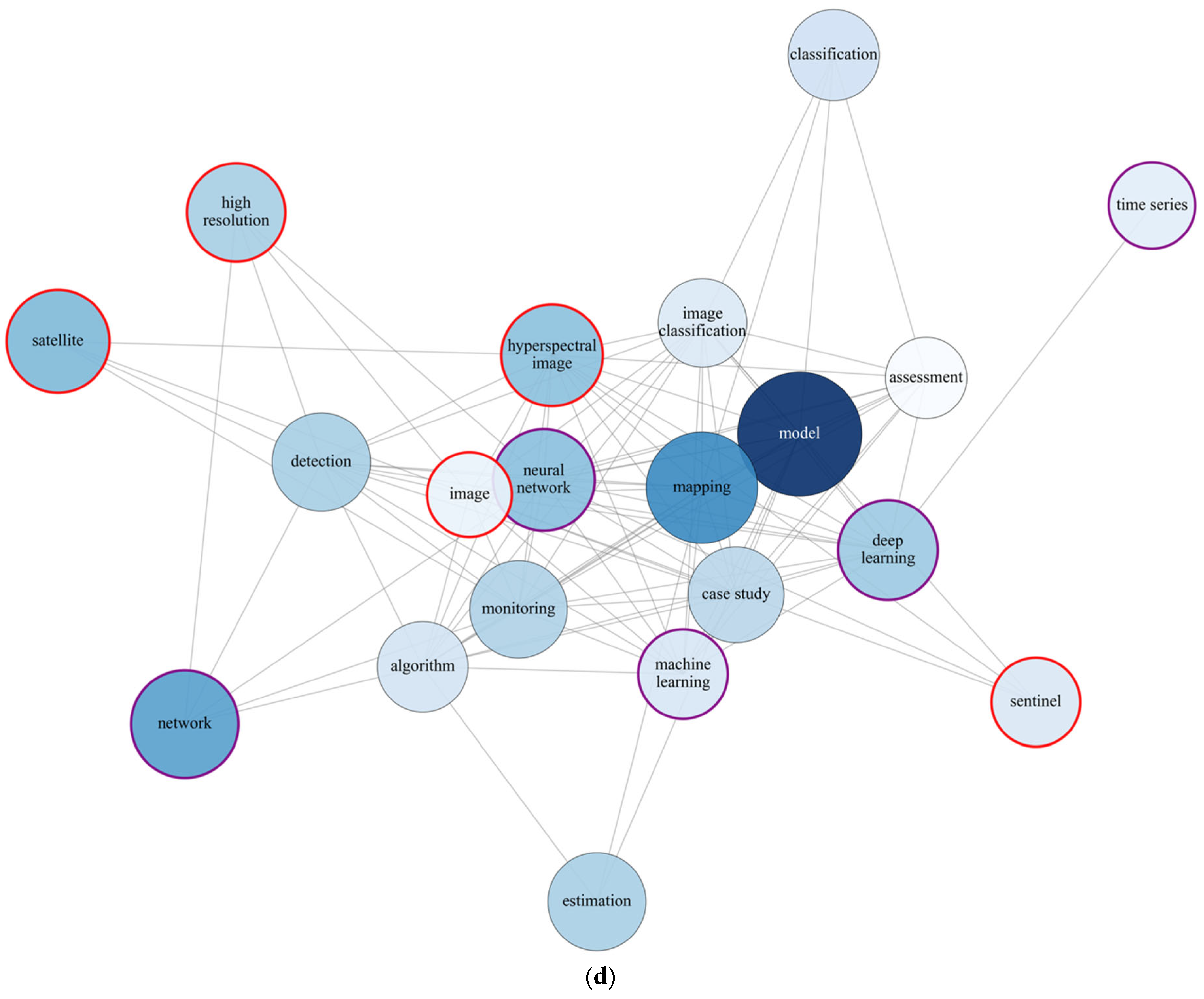
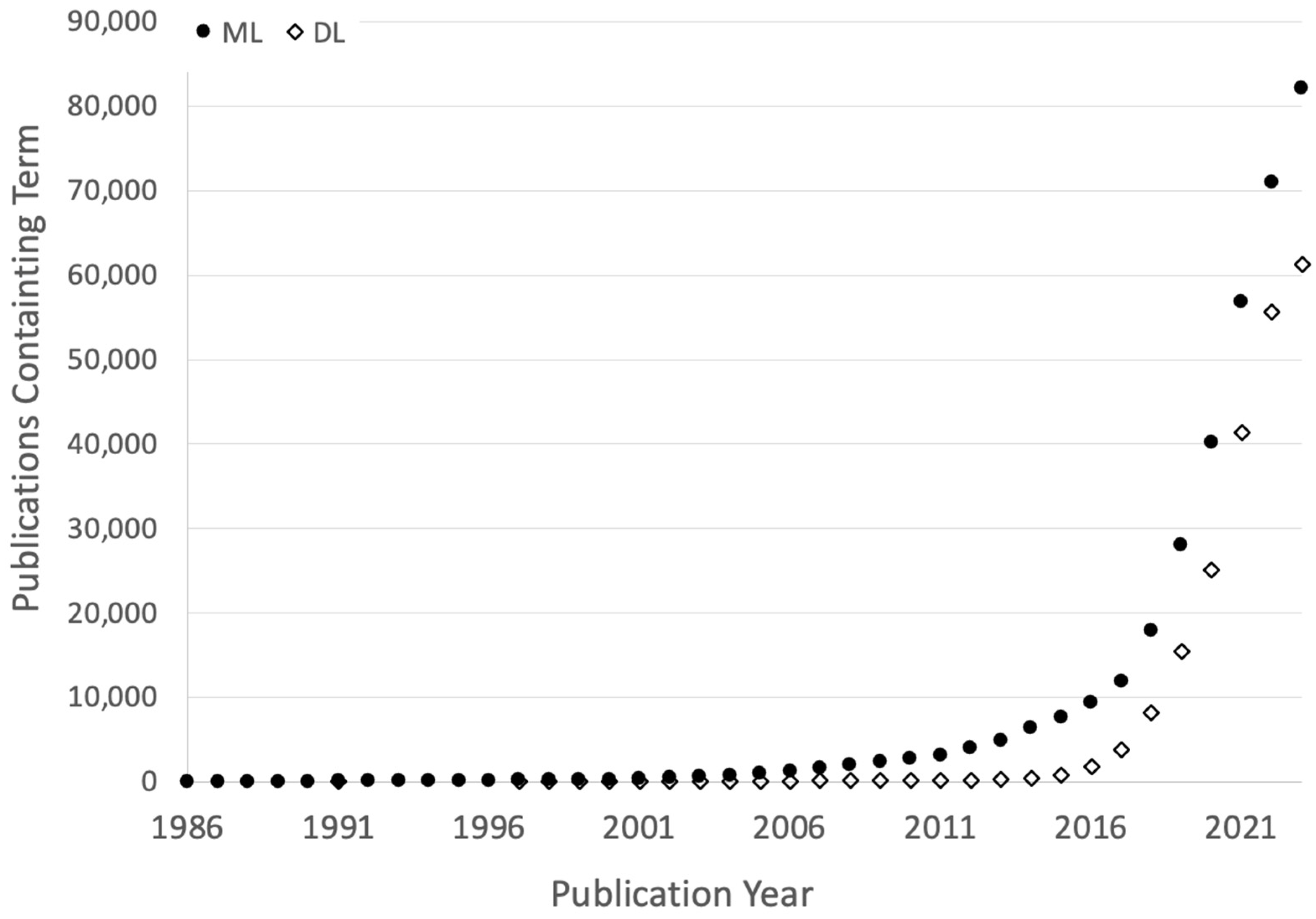
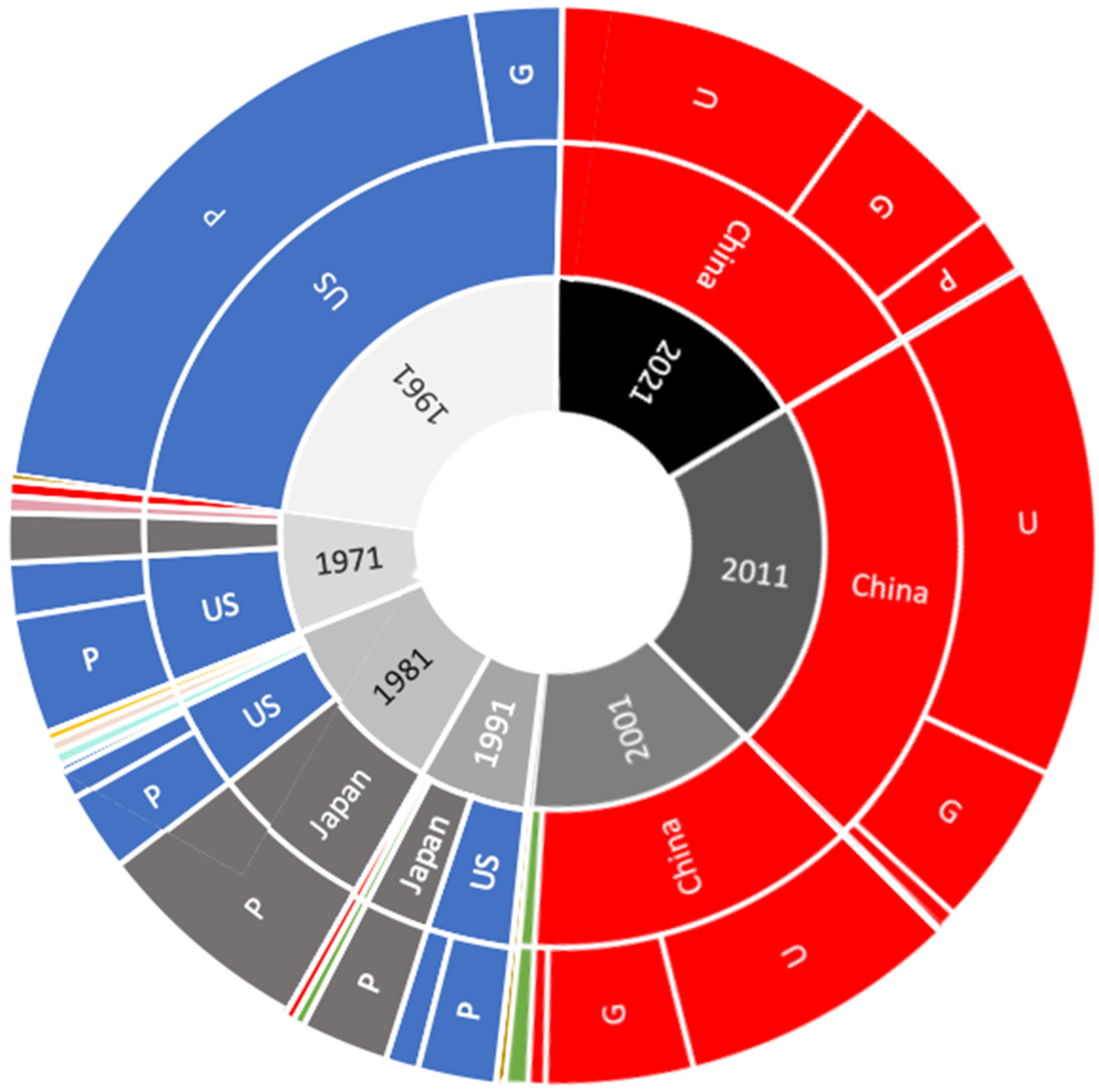
| Period | Av. Number of Papers/Yr | Number of Journals | Av. Papers per Journal/Yr | Total Papers |
|---|---|---|---|---|
| 1961–1970 | 14.7 | 9 | 1.63 | 147 |
| 1971–1980 | 104.9 | 25 | 4.20 | 1049 |
| 1981–1990 | 575.7 | 33 | 17.45 | 5757 |
| 1991–2000 | 967.0 | 31 | 31.19 | 9670 |
| 2001–2010 | 1640.3 | 36 | 45.56 | 16,403 |
| 2011–2020 | 5308.5 | 43 | 123.45 | 53,085 |
| 2021–2023 | 13,456.0 | 43 | 312.93 | 40,368 |
| Years | 1961–1970 | 1971–1980 | 1980–1990 | 1991–2000 | 2001–2010 | 2011–2020 | 2021–2023 | 2021–2025 * |
|---|---|---|---|---|---|---|---|---|
| Patents | 92 | 368 | 1934 | 4974 | 15,944 | 72,830 | 43,048 | 58,953 |
| Per year | 9.2 | 36.8 | 193.4 | 497.4 | 1594 | 7283 | 14,349 | 17,864 |
| Country | 1980–1999 | 1990–1999 | 2000–2011 | Total |
|---|---|---|---|---|
| United States (US) | 393,595 | 602,865 | 1,053,089 | 2,049,549 |
| China (CN) | 139 | 571 | 11,825 | 12,535 |
| Rest of the World (RW) | 314,738 | 504,955 | 1,005,371 | 1,825,064 |
| Total | 708,472 | 1,108,391 | 2,070,285 | 3,887,148 |
Disclaimer/Publisher’s Note: The statements, opinions and data contained in all publications are solely those of the individual author(s) and contributor(s) and not of MDPI and/or the editor(s). MDPI and/or the editor(s) disclaim responsibility for any injury to people or property resulting from any ideas, methods, instructions or products referred to in the content. |
© 2025 by the authors. Licensee MDPI, Basel, Switzerland. This article is an open access article distributed under the terms and conditions of the Creative Commons Attribution (CC BY) license (https://creativecommons.org/licenses/by/4.0/).
Share and Cite
Laefer, D.; Hua, J. Remote Sensing Publications 1961–2023—Analysis of National and Global Trends. Geomatics 2025, 5, 47. https://doi.org/10.3390/geomatics5030047
Laefer D, Hua J. Remote Sensing Publications 1961–2023—Analysis of National and Global Trends. Geomatics. 2025; 5(3):47. https://doi.org/10.3390/geomatics5030047
Chicago/Turabian StyleLaefer, Debra, and Jingru Hua. 2025. "Remote Sensing Publications 1961–2023—Analysis of National and Global Trends" Geomatics 5, no. 3: 47. https://doi.org/10.3390/geomatics5030047
APA StyleLaefer, D., & Hua, J. (2025). Remote Sensing Publications 1961–2023—Analysis of National and Global Trends. Geomatics, 5(3), 47. https://doi.org/10.3390/geomatics5030047







